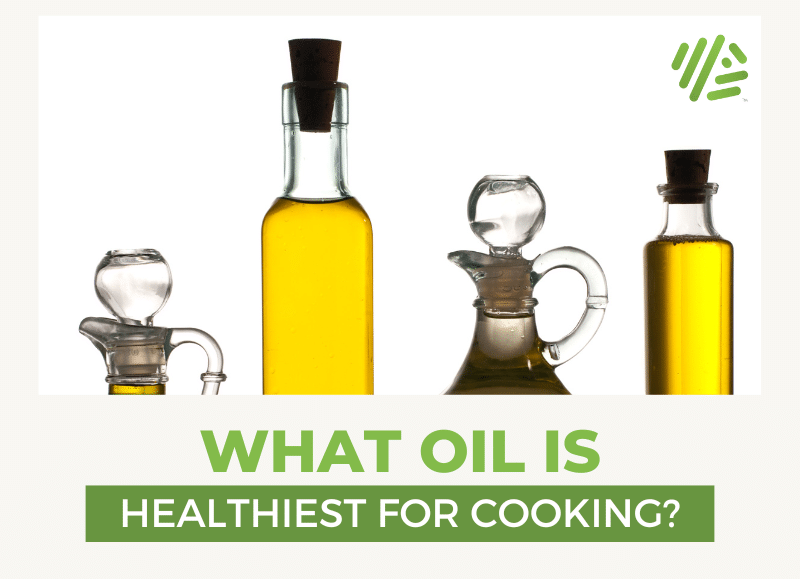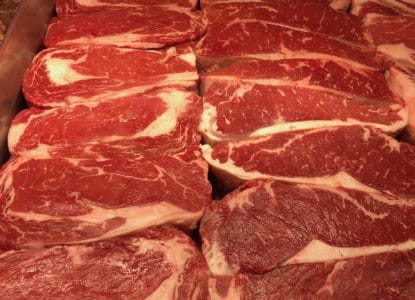How to Choose the Healthiest Cooking Oil Based on Smoke Point

Contents
- Cooking Oil Smoke Points and Why They Matter
- Is Extra Virgin, Cold-Pressed, Unrefined Oil Better?
- High-Temperature Cooking Oils
- Benefits of avocado oil for cooking
- Cooking Oils and Flavor – Lower Temperature Cooking
- Raw Oils for Salad Dressings
- The Healthiest Cooking Oils
- Trans fats in cooking oils
- The Bottom Line
If, like me, your kitchen cupboards are full of different types of oil, but you automatically reach for the olive oil when cooking, it’s time to shake things up.
Knowing which oil is best to cook with in different situations can have a big effect on your enjoyment of food, your health, and the longevity of the batteries in your smoke alarm. I’m not kidding.
Cooking with the ‘wrong’ oil can be disastrous and, frankly, expensive. Different oils have different smoke points, lighter or stronger flavor profiles, and higher and lower propensities to go rancid if stored incorrectly or for too long. What’s a smoke point, you ask? Let’s dig in.
Cooking Oil Smoke Points and Why They Matter
Put simply, the smoke point of an oil is the temperature at which it begins, well, smoking. At one time or another, we’ve likely all left a little oil warming in a pan, only to realize minutes later that the kitchen is getting smoky as that oil burns.
This is what we want to avoid because oil that is smoking is bad news for health (and your pan, probably). The reason oils smoke is because they contain various minerals and flavor compounds that burn at high heat.
- When the oils breaks down and these compounds burn, they can give rise to chemicals that make food taste bitter or burnt.
- These chemicals can also have negative health effects and cooking an oil above its smoke point generates free radicals that can damage your cells and tissues.
- The higher the level of free fatty acids in a fat or oil, the lower the smoke point because free fatty acids are less stable than bound fatty acids.
- Older oils have a lower smoke point than fresher oils, which is one reason why buying in bulk doesn’t always make sense for cooking oils.
Heat tolerance of cooking oils
- In general, refined vegetable oils such as high-oleic safflower or sunflower oils can be heated to 500°F (280°C) or above.
- Refined corn oil, peanut oil or soy oil can be heated to around 450°F (230°C).
- Unrefined vegetable oils should be used at temperatures below 225°F (105°C). These oils include unrefined canola, flaxseed, safflower and sunflower.
- Vegetable shortening will smoke at around 325°F (163°C), and butter at around 350°F (176°C).
- Lard will start smoking between 360°F and 400°F (182°C and 204°C).
Is Extra Virgin, Cold-Pressed, Unrefined Oil Better?
Oils labeled as cold-pressed, raw, virgin, or unrefined are those that are extracted using low or no heat processes and immediately bottled, along with all their minerals, enzymes, and other nutrients.
These unrefined oils are more prone to breaking down and going rancid when exposed to high heat, air, and light, so are best bought in smaller quantities in opaque glass bottles and stored in a cool, dark cupboard or the refrigerator.
They should be used for finishing drizzles, salad dressings, or, at a stretch, very low heat cooking.
Top-Tip – If you’re looking for the best of the best in culinary oils, check to see if an oil is extracted without hexanes. Cold-pressing is far better for health as it preserves many of the beneficial constituents of an oil without introducing potentially toxic chemicals.
High-Temperature Cooking Oils
‘Raw’ oils tend to contain more of the minerals and flavor molecules and compounds that reduce the oils’ smoke point. In contrast, clarified or refined oils, such as refined coconut oil and ghee (clarified butter), have had many of these minerals and flavor compounds removed, so they can withstand higher heat without beginning to burn. Cooking oils that are stable at high temperatures are your best bet for searing, sautéing and frying as these are all high-heat cooking methods. These oils have little flavor, however, which is why it’s best to reserve them for these types of cooking rather than for, say, making a salad dressing or spreading on your bagel in the morning. Some options for neutral oils with smoke points over 400 degrees Fahrenheit include refined:
- Peanut oil
- Vegetable oil
- Canola oil
- Safflower oil
- Corn oil.
Remember, though, that refined oils are highly processed. After extraction and pressing, the oils may be subjected to bleaching, heating at high temperatures, deodorizing, and filtering, to remove those compounds that easily break down. The resulting oils have a neutral flavor, a long shelf-life, and a high smoke point. These oils are not actually healthy, however, as they now contain trans fats and residual hexanes. As such, they should be used sparingly or not at all if you can help it.
Benefits of avocado oil for cooking
Avocado oil is one of the best options for high-temperature cooking as it has a naturally high smoke point of around 520 degrees Fahrenheit!
Avocado oil is low in PUFAs, rich in MUFAs, and contains more saturated fat than olive oil but less than most animal fats. This makes it perfect for searing meat and for a veggie stir fry cooked in a wok on high heat. Rice bran oil also has a naturally high smoke point of around 495 degrees Fahrenheit but is less available than avocado oil in most places.
Cooking Oils and Flavor – Lower Temperature Cooking
If you’re cooking vegetables or other foods at a lower temperature, pretty much any cooking oil will do. In fact, this is a good time to consider the particular flavor profile of an oil and how it will work with your dish overall. For many of you omnivores out there, animal-derived fats such as lard, bacon grease, and duck fat may be your go-to for lower temperature cooking. These animal fats are full of flavor compounds that lower the smoke point of the fat but add to the taste of a dish. That’s not to say these are healthy, of course, given the amount of saturated fat and cholesterol they contain, and the overall contribution of animal agriculture to climate change. Most cooking ‘oils’, in contrast, come from seeds and nuts, including sunflower seeds, almonds, walnuts, olives, avocados, and coconuts, as well as rice bran.
Good options for cooking at a lower temperature include unrefined coconut oil and olive oil. Some olive oil and coconut oil (as well as duck fat) can also work well for slower oven roasting of foods on a lower temperature, but you’ll want to use an oil with a higher smoke point for oven-roasting at higher temperatures. The smoke point of extra virgin olive oil can range from just 325 degrees Fahrenheit to 375 degrees Fahrenheit, so it’s wise to do a quick test of smoke point before committing to using any particular olive oil to cook for your next dinner party. If you’re just using cooking oils to carry the flavors of other foods in your dish, however, you’ll want to pick something more neutral, such as safflower or soybean oil, which don’t interfere with other flavors.
Raw Oils for Salad Dressings
If you don’t plan to actually cook with a cooking oil, and you’re looking for an oil with some savory flavor, consider pumpkin seed oil, flax oil, or walnut oil. Darker, unrefined sesame oil is also best suited to use in dressings and drizzles as it has a lower smoking point than lighter, refined sesame oil. Try using sesame oil and a little liquid smoke mixed with apple cider vinegar, salt, and lime juice as a dressing for a vegan tofu poke bowl.
The Healthiest Cooking Oils
At minimum, the healthiest cooking oils are those well suited to the type of cooking you’re doing. By paying attention to smoke points, you can minimize the production of free radicals and undesirable chemicals, which reduces the risk of oxidative damage to your cells and tissues.
Choosing the healthiest cooking oil isn’t just about minimizing the negatives, though. Let’s accentuate the positives too by choosing oils high in beneficial monounsaturated and polyunsaturated fatty acids (MUFAs and PUFAs, respectively). These types of fats help keep cell membranes fluid and functional, can cut your risk of heart disease and stroke, help support cognitive health and skin health, and have a whole host of other benefits.
The trick here, however, is to avoid cooking at high temperatures with oils that are rich in either MUFAs or PUFAs and, ideally, not cooking at all with PUFA-rich oils. Heating these oils damages the fats, which, in turn, damage your cells and tissues. Also, not all PUFAs are the same and we need to maintain a good ratio of the PUFAs omega 3, 6, and 9, for good health. Most diets tend to be high in omega 6, but it’s generally recommended to aim for a ratio of no more than 15:1 of omega 6 to omega 3, and ideally closer to a 1:1 ratio.
How you buy and store your oils is also important as those high in PUFAs are liable to be damaged by exposure to light, heat, and air. As noted above, it’s best to buy high quality cooking oils in small quantities, only purchase those in dark glass bottles, and be sure to store them in a cool, dark cupboard or the refrigerator. I’m no fat-free cooking advocate by any means, but I am on board with getting most dietary fats in whole food form, from unprocessed nuts, seeds, olives, and other plant foods.
Trans fats in cooking oils
Any discussion of the healthiest cooking oils needs to take note of trans fats. Despite mumblings to the contrary, cooking with PUFAs and MUFAs doesn’t cause these fats to become trans fats. However, manufacturers of spreads, margarines, baked goods, breads, and such may put these fats through a hydrogenation process to make them harder at room temperature. This process does create trans fats, which are bad news for your heart, blood vessels, and many other aspects of good health. Trans fats are also present in the majority of PUFA-rich vegetable oils that have been refined and deodorized, along with nasties like hexanes. Choosing cold-pressed, unrefined, and virgin oils can help, but bear in mind that these are not protected terms and while you’ll pay a lot more at the store for such oils, manufacturers will often blend these with lesser quality oils to reduce manufacturing costs. Buying from a reputable company and asking manufacturers outright about their extraction, refining, and blending processes can offer some insight into what’s in a cooking oil.
Trans fats are also found naturally in animal-derived products, making up around 3-7% of the fats in dairy products and a slightly lower percentage of the fats in meats (R). These trans fats may be less harmful to health than artificial trans fats, although this could be, in part, because the quantities consumed are usually lower (R). Recognizing that trans fats are bad for health, many European countries have banned or are in the process of banning these from food products. Denmark did this way back in 2003! As usual, the U.S. Food and Drug Administration has taken a while to catch up, but they did enact a ban on trans on June 18, 2018. Products manufactured before this date can still be distributed until January 2020, or 2021 in some cases (R). The ban isn’t foolproof, however, as foods that contain less than 0.5 grams of trans fats per serving can still be labelled as having 0 grams of trans fats (R). Given that most folks don’t stick to a single ‘serving’ of any given food, this could create a false sense of security for many.
The Bottom Line
Knowing your oils might not turn you into a master chef, but it can certainly help. And, now you know which oils to cook with, you’ll want to make sure you’re using the best non-toxic, eco-friendly cookware too!




So you haven’t heard of tea seed oil? 485 degree smoke point, high linoleic acid and Oleic acids, vitamins A,B,D, E, no trans fat, contains squalenes and flavonoids. By far the best choice for high heat cooking!
What do you think about pure light oil for cooking and frying?